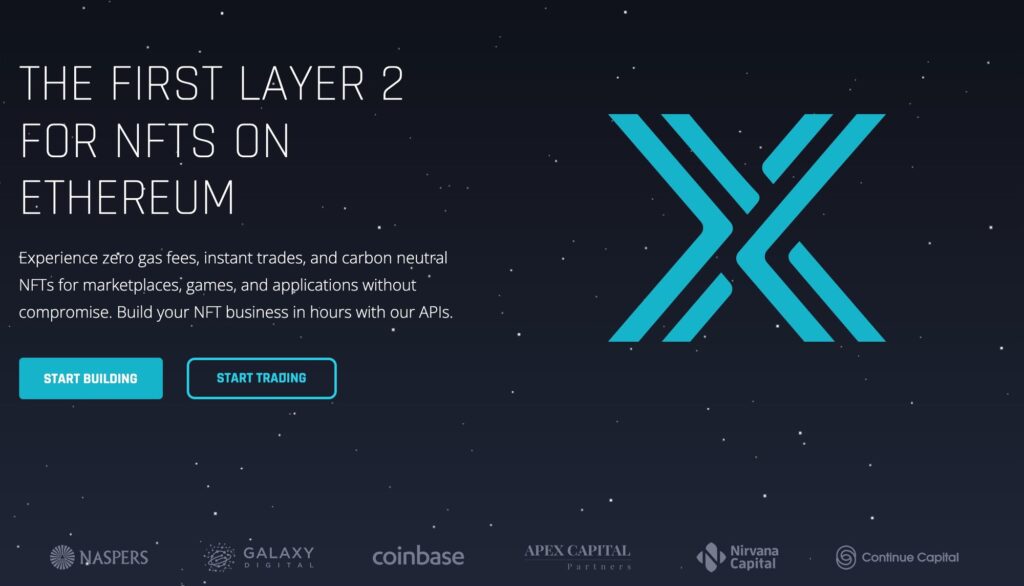In this article, I’ll explain what is Immutable X and if solutions like it simplify buying and selling NFTs.
Immutable X is a layer 2 solution built on the Ethereum blockchain for NFTs.
Immutable X is designed to facilitate secure, free, and fast non-fungible token trades. It’s also aimed at NFT project creators who want to launch their NFT businesses quickly and easily.
What?! That’s a lot of technical concepts to unpick. Here’s a caveat before I explain more:
I’m not a financial advisor and NFTS are incredibly risky. I published this content is for informational purposes only. Always do your own research.
Previously known as Fuel Games, the company Immutable began developing the IMX token marketplace in 2019 after receiving funding from investors like Coinbase and Galaxy Digital. Their goal was to create a successor to the Gods Unchained Marketplace, its digital trading cards game, and also tackle some of the problems with using Ethereum.
They launched Immutable X the IMX token in 2021. The token is designed to facilitate trades, staking, and governance on the platform.
Layer 1 is a technical term describing the underpinning blockchain, in this case, Ethereum. Layer 2 represents an overlaying network built on top of Layer 1, in this case, Immutable X. Think of Ethereum as like the foundations and Layer 2 solutions like a house that stands on top.
Ethereum is a layer one solution with a marketcap of approximately $533 billion. It’s also ranked number two on Coinmarketcap. Polygon MATIC is a popular layer two alternative to Ethereum. And at the time of writing, it has a market cap of $13 billion and is ranked in the top 20.
When writing this article, the Immutable X marketcap was approximately $1.7 billion and in the top 100. But, if Immutable X games wide stream adoption, the token and marketplace could become valuable.
The Immutable team also launched a marketplace where NFT fans can trade their wares, although it’s sparse at the time of writing. They’ve created IMX, an ERC-20 token for rewarding users. Immutable is planning on releasing staking for IMX holders. If you’re a critic of NFTs, Immutable X is carbon-neutral too.
The project appears to be heavily aimed at NFT gamers. The white paper reads:
Gaming is currently a USD 300 billion industry and is expected to grow roughly 10% a year between 2021 and 20252, making it larger than the sports, movie and music industries combined.3 Since 2018, players have spent more than USD 100 billion on in-game assets, such as unique character skins, items and exclusive unlockable content. This content is a fantastic opportunity for tokenization: every one of these assets would be more valuable to users if it were represented by an NFT.
Using Immutable X to Buy NFTs
During the summer, I purchased The Doge Pound NFT on OpenSea using Ethereum (Layer 1). Around Halloween, the project owners released a free token that holders could claim if they owned a Doge Pound NFT.
Usually, airdrops involve interacting with a website using the Ethereum blockchain. Anytime you interact with the Ethereum blockchain, expect to pay gas fees. If you want to buy an NFT, claim, mint, or an NFT, it’ll cost you.
If you have a big NFT budget, you’re probably not worried much about gas fees. But, when I first started buying NFTs, I spent a good chunk of my budget paying crazy gas fees to use the Ethereum blockchain.
It’s difficult for everyday investors and those curious about buying NFT to eat the cost of gas. Many NFTs are expensive, to begin with!
In short, the Ethereum blockchain is slow to build on and expensive to interact with, buyers and creators.
Some solutions exist to counter the cost of Gas or Gwei and the slow speed of the platform. You can use Matic and the Polygon network. Another popular alternative to Immutable X is Flow. Created by Dapper Labs, Flow announced a partnership with NFT marketplace OpenSea early in 2021. It’s also what powers the NBA Top Shot marketplace.
Now, you can also use Immutable X. I received my NFT from The Doge Pound project for free straight to my Immutable X wallet.
I haven’t purchased any Immutable X tokens, but I’m interested in following the project and its impact on the NFT space. Plus, if it means paying less gas, that’s a big plus.
The Problem With Buying NFTS
I spent several hours reading up on layer one and layer two solutions and wading through technical documentation and the Immutable X whitepaper to figure the differences.
I learnt layer two solutions are supposed to reduce the workload on the Ethereum blockchain and make buying, selling, and interacting with NFTs faster and cheaper. But the whole experience reminded me of buying a computer in 1995. That was a painful experience.
Pullouts from computer magazines back then went into great detail about the RAM, hard drive space, processor speed, megahertz, bits, and bytes. Deciphering technical wizardry stats was fun for computer nerds like me, but off-putting for others.
When computer companies simplified their language and began speaking in customers’ words, buying a computer became much easier. Cue mainstream adoption.
If you’re buying an iPhone or an Android device, you can find some technical information on company sales pages, but tech speak is usually further down the page or explained in detail. Consumers prefer hearing about what their iPhone or Android can do, the latest benefits, and what the camera is like.
Until we see cryptocurrency and NFTs explained using everyday language, it’s difficult to see how most people will navigate the NFT space. We want to hear about NFT real world use cases!
That said, Immutable X is a great breakthrough because it’s cut down the cost of gas fees and is faster than using a Layer 1 solution. It’s also an NFT project I intend to follow closely.

